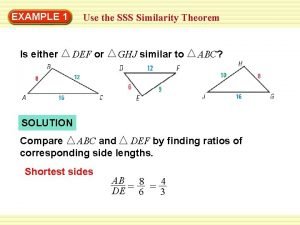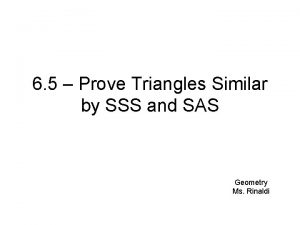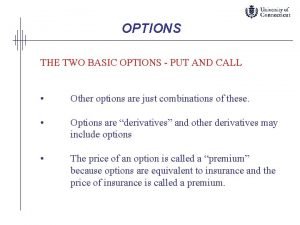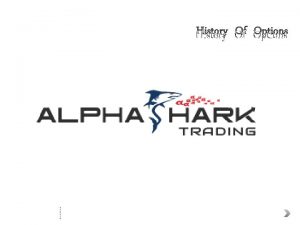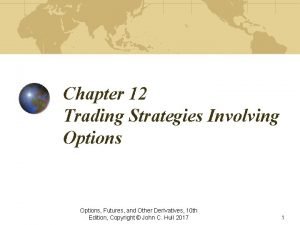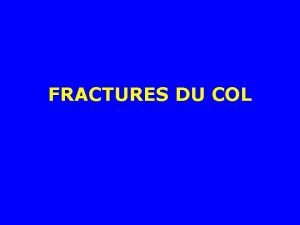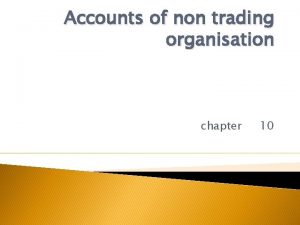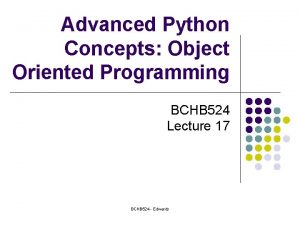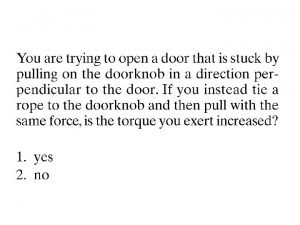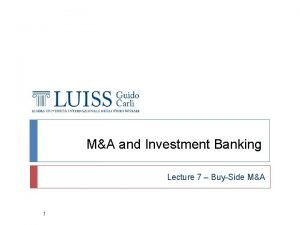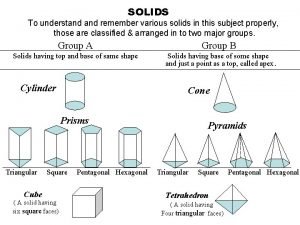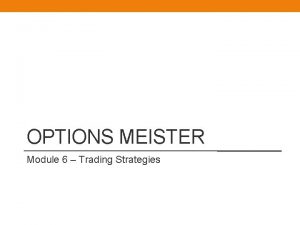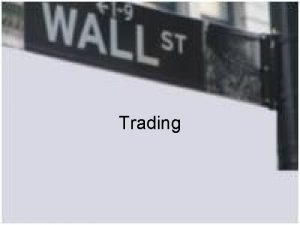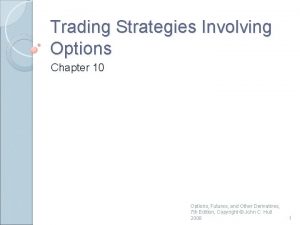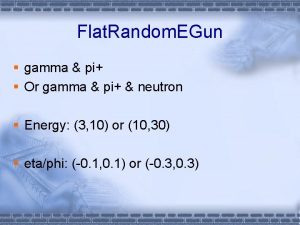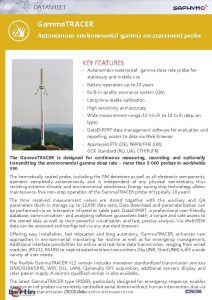Trading Gamma Trading options from the long side


































- Slides: 34

Trading Gamma: Trading options from the long side And evaluating risk Option Pit

What we will cover • • • Trade setup checklist Using realized volatility to set up the trade Quantifying risk and real IV cost SPX and AAPL trading Generating buy ranges for volatility New opportunities

Setting up a Trade • • • Identify the opportunity in the long gamma Learn to quantify the risk Create the position Generate the financing mechanism Manage the strategy • Rinse and Repeat

Mean Reversion • A stock price can go anywhere and stay there • While volatility can GO anywhere, it cannot stay anywhere • Another way to think about mean reversion is how IV changes and how options change price • How do options perform as the underlying picks up movement?

Realized Volatility • Gamma trading is realized volatility trade • We want the underlying to move more than the straddle value for the time period That is the easy part Isn’t the market efficient? No, the liquidity provider keep things in equilibrium not efficient

Learn the Product • IV 30 - grabs the terms in IV near 30 days out • IV 60 -grabs the terms in IV near 60 days out • IV 90 -grabs the terms in IV near 90 days out – For very short term Sigma use 10 day RV as an idea – What we mean here is “how cheap does it get” – IV almost always can get cheaper than you think


Ride the Wave (From the Vol Master Class series)

Implied Volatility • Using the 5 factors – Price, Strike, Time to Expiration, Cost of Carry, and Volatility • Implied Volatility is actually an OUTPUT based on current option prices – IV <= Option Price, Strike, Time to Expiration, Stock Price, Cost of Carry • Note that time is a factor in the implied volatility calculation

SPX Term Structure and finding Gamma edge Where is the term relative to the Weekend?

Days in the Life of the Option Oct 03 1 of 3 days actively traded Oct 05 3 of 5 days actively traded Oct 07 5 of 7 days actively traded

Questions about Daily Term Structure • What are we looking at? – Each volatility term has a different “Sigma” or IV average for the term • Why is each one different? – They are pricing both volatility and time – The options are decayed which shows up as a lower IV – But you get the lower IV price for the short term

Theta and the Weekend • The option pricing model assumes that theta decay is constant. Thus it occurs on the weekends (theoretically) too. • But does it? – NO: T. A. N. S. T. A. F. L. !!! – Market makers aren't stupid, over the 5 days of trading in a week, they take out 6 days and a wake -up decay from options

Finding edge in Realized Vol • We are playing a mathematics game using expected movement and what the market is charging us for that movement • Time frame plays a key roll • Basically we buy low and manage theta the best we can • ABC Always Be Closing since gamma cost money

Let’s Review the Realized Vol

Option IV compression and time in the very short term

SPX trade from the SL • We bought 5 SPX Feb 03/06 2270 put spreads for 1. 85 for a short delta and $10 move – And we decided to buy the calls around 2285 SPX on a rally oh and it rallied • OUCH!

Here is the trade balanced to risk

Adding up the risk profile • Adding 2 calls early would have been a cheap gamma bet into NFP • Old Greeks – -77 Deltas, short 4 Gamma, long 100 Theta • New Greeks – Long 2 Deltas, long 1 Gamma, long 110 Theta! • There is some platform issues but still…… • Vega is not really a risk with the day decayed out and 6. 5% IV

Let’s go through the trade process • The opportunity was in the forward decayed options in to Monday meaning you got to buy 6. 1% IV and hold it through NFP • The risk for the gamma overnight was almost nothing except for a strong down opening 1% or more and even then… • We used a ratio in the put time spread and call to make the risk profile flat ATM but expand on a move • Slightly long theta was no decay risk • Management would be close the tails

Setting up a Trade review • • • Identify the opportunity in the long gamma Learn to quantify the risk Create the position Generate the financing mechanism Manage the strategy • Rinse and Repeat

AAPL in the midterm

AAPL options note the Sigma and ATM VOL

From the SL Jan 25 th

Let’s fill in the trade blanks • AAPL IV into the midterm is at 2 year lows if not 5 year lows – The vega risk here is very small maybe 1 or 2 points or around $400 for this trade size • We actually pick up an earning cycle and low IV at the same time • AAPL realized vol is low generating the low IV so most likely we need a management routine after the earnings

Let’s go through an AAPL vega exercise

What happened to the IV’s?

Completing the trade plan • AAPL IV opportunity in the midterm caused by trending RV and a near free look at earnings • The Vega risk was around $400 but turned out to be nothing since we bought cheap • The simple delta neutral strangle should not decay until earnings (and it did not) • We finance by selling near options on a ratio • We unwind winners and sell near term to manage

Volatility Generalizations • We keep the “wind” of volatility to our back whenever possible – Let mean reversion take the position where it wants to go – This is important when looking for options to buy – The lower IV keeps things from decaying too fast

FB versus GLD • Let’s say you sell premium • Long Gamma Positions are a natural hedge but you wan them to make money too • Now you are in the business of buying some gamma – The name is irrelevant it is just the risk profile we want – What gamma do you like better? The prices are about the same so let’s compare

Setting up a Trade review • • • Identify the opportunity in the long gamma Learn to quantify the risk Create the position Generate the financing mechanism Manage the strategy • Rinse and Repeat

FB

GLD

Questions?
 Sss
Sss Similarity theorems
Similarity theorems How to prove triangles similar
How to prove triangles similar Similar picture
Similar picture Delta scalping
Delta scalping Long and short
Long and short Once upon a time there was a little red fox
Once upon a time there was a little red fox Từ ngữ thể hiện lòng nhân hậu
Từ ngữ thể hiện lòng nhân hậu Ichimoku
Ichimoku What is option trading
What is option trading History of options trading
History of options trading Trading strategies involving options
Trading strategies involving options Lame plaque femur
Lame plaque femur Non trading organisation definition
Non trading organisation definition Side by side stuff
Side by side stuff Glass will break first on the weaker side, the side:
Glass will break first on the weaker side, the side: Videocon refrigerator temperature settings
Videocon refrigerator temperature settings Regular hexagonal lamina has
Regular hexagonal lamina has Opposite side adjacent side and hypotenuse
Opposite side adjacent side and hypotenuse Side angle side theorem
Side angle side theorem Red side blue side
Red side blue side Lingualized occlusion definition
Lingualized occlusion definition Uil side by side
Uil side by side Perfect competition side by side graphs
Perfect competition side by side graphs Client side and server side
Client side and server side Two wheels roll side by side
Two wheels roll side by side Melkgeschirr aufbau
Melkgeschirr aufbau Sell side vs buy side
Sell side vs buy side Posselt's envelope of motion
Posselt's envelope of motion Elementary welding symbols
Elementary welding symbols Tubal ligation side effects
Tubal ligation side effects Perpindicular bisector
Perpindicular bisector A pentagonal pyramid, base 25mm side and axis 50mm long
A pentagonal pyramid, base 25mm side and axis 50mm long Once upon a time there was a kingdom
Once upon a time there was a kingdom Long long ago when the gods and goddesses
Long long ago when the gods and goddesses
